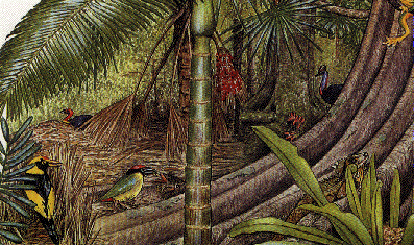[Deserts]
[Mangroves]
[Scrublands]
[Waterways]
[Forests/Woodlands]
[Seashore]
[Rainforests]
[Heathlands]
[Tropical Wetlands]
[Alpine]
[Urban]

| Australian Habitats: | Back to Session Topic 2 |
Australia has a large range
of habitats, due to its size and climates. The information on this page
will explain the characteristics of each habitat. At the bottom of the
page is a series of questions you need to answer. Make sure you read this
page carefully and underline the important parts. Click on the links below
to take you to that part of the page:
[Deserts] |
 |
| 1. Which habitat is described as being "very delicate" and is a vital breeding ground for marine life? |
| Answer: |
| 2. How long is Australia's Great Barrier Reef? |
| Answer: |
| 3. In which habitat would you most likely find eucalypts, also known as "gum trees"? |
| Answer: |
| 4. How low can temperatures fall in Alpine areas? |
| Answer: |
| 5. Which continent is the driest continent on Earth? |
| Answer: |
| 6. Which habitat is home to some of Australia's most unusual creatures (Eg. platypus)? |
| Answer: |
| 7. How much of Australia's rainforests have been destroyed in the last 200 years? |
| Answer: |
| 8. The plants in which habitat rely on fires to help their seeds germinate? |
| Answer: |
| 9. Which habitat is full of dangers for most Australian animals? |
| Answer: |
| 10. Which areas are "the lifeblood of the dry Australian continent"? |
| Answer: |
© Created By AJM
NETWorks ©
1 September 2000